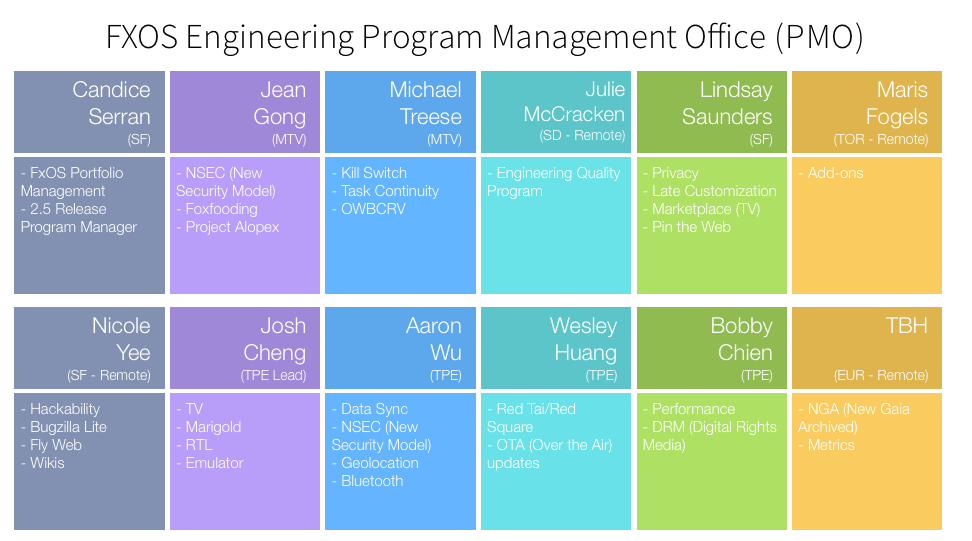Firefox OS/ProgramManagement: Difference between revisions
Jump to navigation
Jump to search
(metrics) |
(programs) |
||
| Line 10: | Line 10: | ||
rect 171 125 320 195 [[NSEC (New Security Model)|NSEC (New Security Model)]] | rect 171 125 320 195 [[NSEC (New Security Model)|NSEC (New Security Model)]] | ||
rect 171 196 320 215 [[Foxfooding|Foxfooding]] | rect 171 196 320 215 [[Foxfooding|Foxfooding]] | ||
rect 171 216 320 230 [[ | rect 171 216 320 230 [[Project Alopex|Project Alopex]] | ||
rect 171 395 320 408 [[TV|TV]] | rect 171 395 320 408 [[TV|TV]] | ||
rect 171 409 320 430 [[Marigold|Marigold]] | rect 171 409 320 430 [[Marigold|Marigold]] | ||
| Line 42: | Line 42: | ||
* [[NSEC (New Security Model)]] | * [[NSEC (New Security Model)]] | ||
* [[Foxfooding]] | * [[Foxfooding]] | ||
* [[ | * [[Project Alopex]] | ||
* [[Kill Switch]] | * [[Kill Switch]] | ||
* [[Task Continuity Description]] | * [[Task Continuity Description]] | ||
| Line 70: | Line 70: | ||
* [[Metrics Description]] | * [[Metrics Description]] | ||
* [[Data]] | * [[Data]] | ||
* [[Engineering Quality Program]] | |||
+ [[OWBCRV]] | |||
Revision as of 02:21, 14 October 2015
FXOS Engineering Program Management Office (PMO)
- FxOS Portfolio Management
- 2.5 Program Manager
- NSEC (New Security Model)
- Foxfooding
- Project Alopex
- Kill Switch
- Task Continuity Description
- Privacy Description
- Late Customization
- Marketplace TV
- Pin the Web
- Add-ons Description
- Aha Admin
- Hackability
- Bugzilla Lite
- Wikis
- TV
- Marigold
- RTL (Right to Left)
- Emulator
- Voice
- Data Sync
- Cloud Storage
- Geolocation Description
- Bluetooth
- Red Tai/Red Square
- OTA (Over the Air) updates
- Performance Description
- DRM (Digital Rights Media)
- NGA (New Gaia Archived)
- Metrics Description
- Data
- Engineering Quality Program
+ OWBCRV
Bugzilla Flags
The team will be using the following whiteboard text for tracking user stories and their priorities in Bugzilla.
Overview
- ONE bug per user story. Implementation tasks and bugs should be marked as blocking the user story bug.
- ALL user stories that are either committed or targeted to a release must have a bug filed.
- If a bug is not a user story it will NOT have any of these flags in the whiteboard.
Data
- The user story id, as found in the Product backlog spreadsheet, is written in the bug whiteboard as "ucid:{id}", eg: "ucid:Browser326".
- The functional team that is responsible for the implementation of the user story is written as "ft:{teamname}", eg: "ft:media".
Format
- Grammar: [ucid:{id}, {release-version}, ft:{team-id}]
- The entire block is contained within square brackets
- Case-insensitive. UCID and ucid are both valid.
- Key and value are separated by a colon (no spaces).
- Key/value pairs are separated by a space and comma.
Examples
- [ucid:System26, 1.3, ft:systems-fe]
- [ucid:Comms27, 1.3, ft:comms]
feature-b2g Flag
The purpose
- The feature-b2g flag is intended to be used to help define scope for a particular release.
- The feature-b2g flag enables us to isolate the particular engineering tasks that make up the completion of the feature in a release time frame.
- feature-b2g version#? is defined as "this feature is being proposed for this release"
- feature b2g- version#+ is define as "this feature has been committed (by the engineering team(s)) for this release"
How to tag
- [meta] bugs features and all dependencies targeted for a particular release should mark feature-b2g flag.
- The feature-b2g flag should assigned to engineering tasks falling under the user stories AND the user stories themselves.
- feature-b2g should flag to feature work only, not polish, enhancement or refactor work. Unless there's a user story dedicated for those work in a particular release. This gives us a more stable feature-b2g bug number and better prediction/tracing.
- You can only mark the flag for engineers assigned on your team - not partner teams.
Who has the permission
- PM and EPM, engineer managers and partner peers have the access

